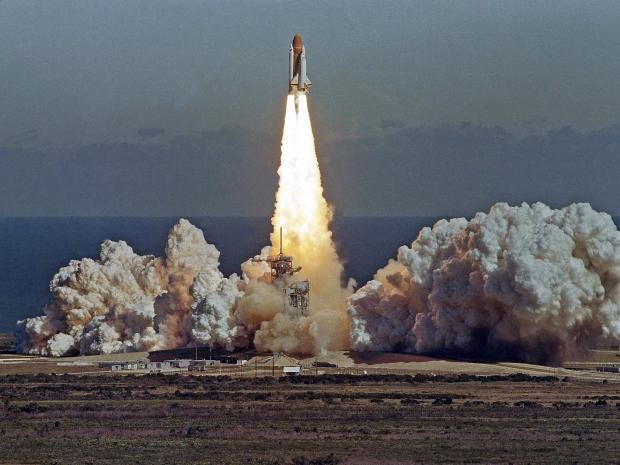

: II-170 Once in space, the crew maneuvered using the two smaller, aft-mounted Orbital Maneuvering System (OMS) engines. : II-5 Three Space Shuttle main engines (SSMEs) were mounted at the aft end of the orbiter and provided thrust during launch. : I-455 The orbiter contained the crew compartment, where the crew predominantly lived and worked throughout a mission. : 5 Challenger (OV-099) was the second orbiter constructed after its conversion from a structural test article. : II-1 Five orbiters were built during the Space Shuttle program. : 363 The orbiter was a reusable, winged vehicle that launched vertically and landed as a glider. : III–148 At launch, it consisted of the orbiter, which contained the crew and payload, the external tank (ET), and the two solid rocket boosters (SRBs). : 5, 195 It flew for the first time in April 1981, : III–24 and was used to conduct in-orbit research, : III–188 and deploy commercial, : III–66 military, : III–68 and scientific payloads. The Space Shuttle was a partially reusable spacecraft operated by the US National Aeronautics and Space Administration (NASA). Main article: Space Shuttle Space Shuttle Challenger - assembled for launch along with the ET and two SRBs - atop a crawler-transporter en route to the launch pad about one month before the disaster Subsequent missions were launched with redesigned SRBs and their crews wore pressurized suits during ascent and reentry.īackground Space Shuttle To replace Challenger, the construction of a new Space Shuttle orbiter, Endeavour, was approved in 1987, and the new orbiter first flew in 1992. NASA managers also disregarded engineers' warnings about the dangers of launching in cold temperatures and did not report these technical concerns to their superiors.Īs a result of the disaster, NASA established the Office of Safety, Reliability, and Quality Assurance, and arranged for deployment of commercial satellites from expendable launch vehicles rather than from a crewed orbiter. Neither NASA nor SRB manufacturer Morton Thiokol addressed the issue.

Test data since 1977 had revealed a potentially catastrophic flaw in the SRBs' O-rings. The commission criticized NASA's organizational culture and decision-making processes that had contributed to the accident. President Ronald Reagan created the Rogers Commission to investigate the accident. The disaster resulted in a 32-month hiatus in the Space Shuttle program. The orbiter had no escape system, and the impact of the crew compartment at terminal velocity with the ocean surface was too violent to be survivable. The exact timing of the deaths of the crew is unknown, but several crew members are thought to have survived the initial breakup of the spacecraft. The crew compartment, human remains and many other fragments from the shuttle were recovered from the ocean floor after a three-month search-and-recovery operation.

Both SRBs detached from the now-destroyed ET and continued to fly uncontrolled until the range safety officer destroyed them. The collapse of the ET's internal structures and the rotation of the SRB that followed threw the shuttle stack, traveling at a speed of Mach 1.92, into a direction which allowed aerodynamic forces to tear the orbiter apart. Shortly after liftoff, the seals were breached, and hot pressurized gas from within the SRB leaked through the joint and burned through the aft attachment strut connecting it to the external propellant tank (ET), then into the tank itself. The record-low temperatures on the morning of the launch had stiffened the rubber O-rings, reducing their ability to seal the joints. The cause of the disaster was the failure of the primary and secondary redundant O-ring seals in a joint in the shuttle's right solid rocket booster (SRB). The latter resulted in a higher than usual media interest and coverage of the mission the launch and subsequent disaster were seen live in many schools across the United States. The crew was scheduled to deploy a communications satellite and study Halley's Comet while they were in orbit, in addition to taking school teacher Christa McAuliffe into space. The mission, designated STS-51-L, was the tenth flight for the orbiter and the twenty-fifth flight of the Space Shuttle fleet. It was the first fatal accident involving an American spacecraft while in flight. The spacecraft disintegrated 46,000 feet (14 km) above the Atlantic Ocean, off the coast of Cape Canaveral, Florida, at 11:39 a.m. On January 28, 1986, the Space Shuttle Challenger broke apart 73 seconds into its flight, killing all seven crew members aboard. Christa McAuliffe, Payload Specialist, teacher.


 0 kommentar(er)
0 kommentar(er)
